How to Avoid Screwing Up Executive-Level Sales Meetings


Executive meetings are high stakes. I mean, have you really sold enterprise if you’ve never sweat through your shirt during an exec-level meeting?
It’s rare for an enterprise rep to spend more than an hour or two with an executive. Yet, every minute together plays an outsized role in the deal’s outcome.
This combo of limited time and large influence makes for high anxiety, and low confidence.
I’ve screwed up my fair share of those precious minutes with executives. So here’s an end-to-end process I’ve developed along the way, to help you nail your next exec-level meeting.
The Value of an Executive Minute
First, recognize that each minute you spend with an executive is worth 16X more than the minutes you'll spend with the rest of the buying team.
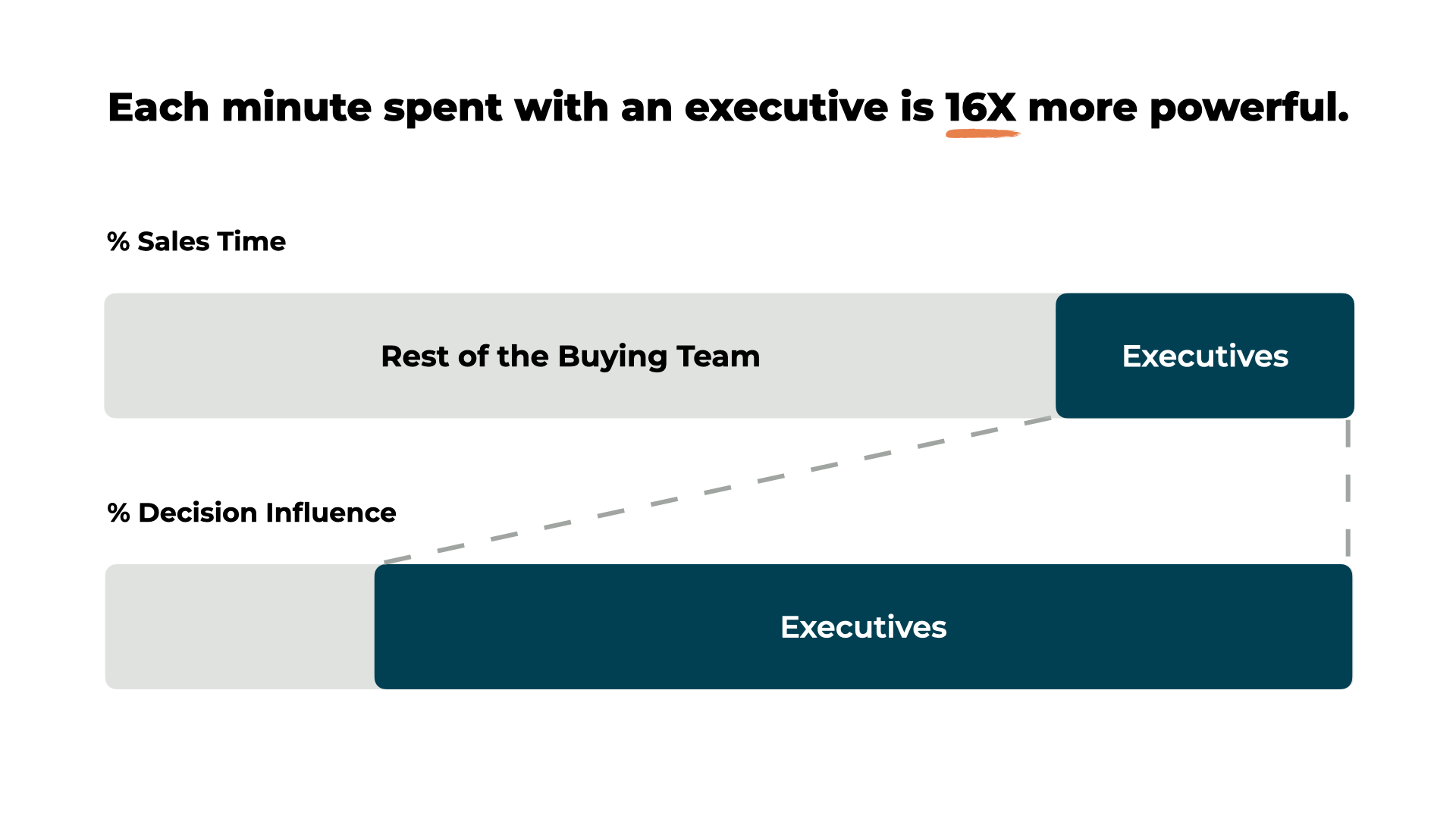
Here’s the math behind this, using two different examples.
- In the first deal, the exec’s involvement follows the Pareto rule. You spend 20% of your sales time with the person who holds 80% of the decision power.
- In the second deal, the exec is less involved. They spend less time in the deal, and delegate more of the decision to their team.
If you look at the ratio of "influence-to-time" in these examples, here’s how it works out:
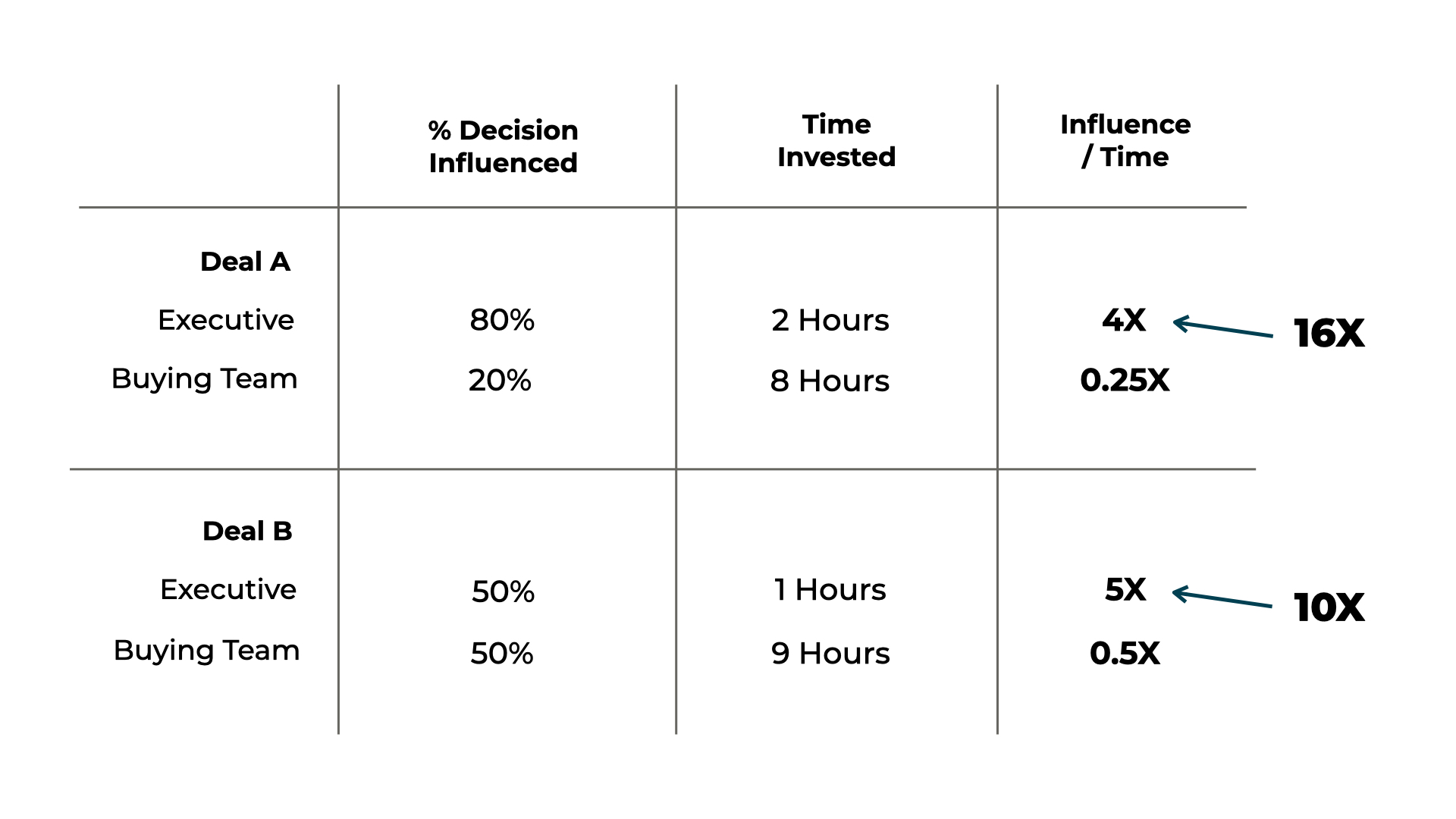
So, it’s fair to say exec-level interactions are at least 10X more powerful in closing deals. Often as high as 16X more powerful.
The logical question, then, is how do you make the most of those minutes?
Five Pre-Meeting Must-Do’s
Fail to plan, plan to fail, as the saying goes. So here are fives steps to make sure you're ready for your next executive meeting.
1/ Build a compelling narrative with your champion.
Executives are in the business of setting a big vision, and seeing it through. They do this by crafting and communicating internal narratives.
You’ll want to be ready with your own narrative, to speak and operate on their level. Narratives transcend products to focus on bigger priorities like:
- Seismic shifts in an industry
- Looming and existential risks
- Massive, untapped opportunities
If an executive isn’t intrigued by your high-level narrative, they won’t go deeper on how to operationalize it (with your product). The key here is to link your narrative to existing stories or “Trigger Phrases” they’re already sold on.
2/ Compress your narrative into a strategic soundbite.
Enterprise reps become crazy good at distilling lots of information into a few sentences.
No matter how complex the topic, or short the meeting. They can deliver their core message in two to three sentences, max.
This helps their message travel. Think of this like compressing a 100 MB file down to 10 MB. You can send it over email, without losing any context, quality, or clarity.
The way to do this with your message is creating a “strategic soundbite.”
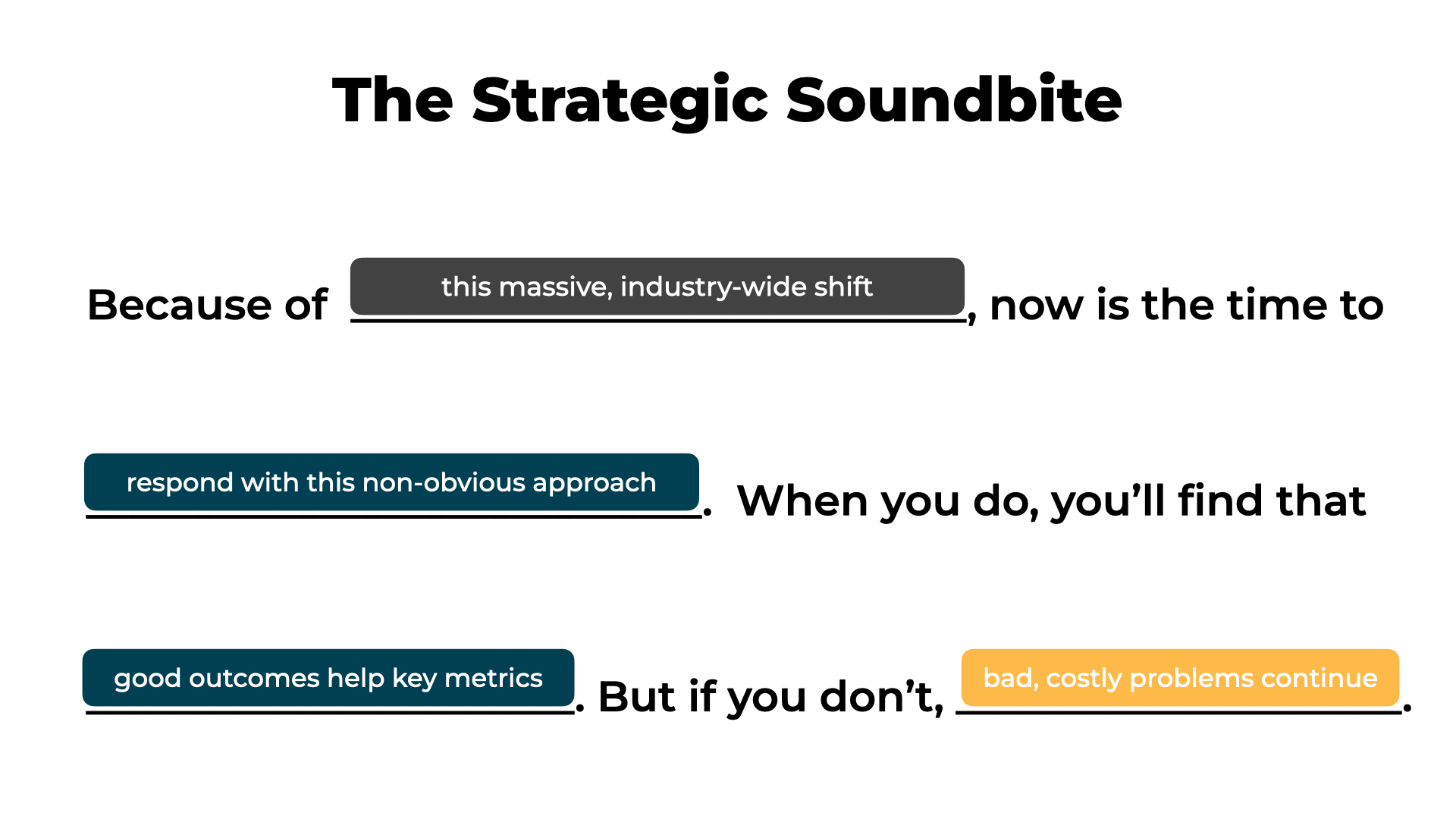
This soundbite is the single, most important thing you want the executive to hear and retain.
3/ Follow the 25% rule for material prep.
Any materials you’re creating (re: above) should take roughly 25% of the meeting time.
For an hourlong meeting, that’s 15 minutes. Or seven minutes for a standard, 30-minute call.
That’s because meetings with executives will likely go off-agenda. Executives almost always have opinions about where they'd like to take the conversation once it gets rolling.
4/ Lock down the executive whisperer’s support.
A small handful of people typically hold a "no-questions-asked" level of trust with executives.
If they nod “yes” during your meeting, it gives the executive confidence to push forward. They'll grow committed to exploring your project more deeply.
If you don’t get the nod, well, get ready for an uphill battle.
If the exec whisperer isn’t already your champion, meet them ahead of time to discuss:
What area of this project gives you most concern?
If it were to go off the rails, why do you think that would be?
5/ Attach a short memo to the invite as a pre-read.
I strongly encourage writing down your business case. When an executive reads your message, you’re judged by your content, not your charisma or delivery.
An Executive Assistant taught me one of my favorite sales practices for this. It's helped me win a multi-year deal with a Top 5 insurance SVP.
Here's how it works:
- Set the calendar invite to start at :05 after.
- Attach your 1-page business case to the invite.
- Let the EA know there's a pre-read in the invite.
- Join the call at :05 after and dig in together.
The other reason this works?
Executives are sharp. They think clearly, and process information far faster than the pace of a typical sales conversation.
Sharing a pre-read (without expecting any "homework" to be done), tees up the topic so you can both drive toward what's most important. Not every executive will be a fan, so ask their assistant or your champion while setting up the invite.
A Minute-by-Minute Meeting Breakdown
I’m a fan of Kyle Asay's saying, “Outcomes, not agendas.”
Overall, you want to ensure each minute of your meeting drives toward a specific outcome the executive cares about. Here's how to structure your time together, to move toward that outcome.
Deliver a Non-Obvious Insight
(Minutes :00 - :05)
Executives decide whether you’re more or less interesting than the other topics and priorities on their mind during the first minutes of your meeting.
This means you need to earn their attention, fast.
Delivering a different and non-obvious take on a topic they care about is how you’ll do this.
This is first done in your pre-read (step 5 of prep). It’s also baked into your narrative (step 1 above). But to be sure you can hold their attention, fill in this sentence:
Most people believe _________, but actually, ___________.
Adapt to Their Quirks
(Minutes :05 - :10)
Every executive is a little odd in their own way. They develop a certain style of working over the years. Your job is to understand and adapt to those quirks.
For example, I’ve had meetings with executives who:
- Cut me off, constantly. A CEO of a large payments platform would show he was engaged by trying to finish my sentences. He wasn’t rude. He was excited. So I learned to speak in short, fast sentences to let him jump in.
- Refused to look at slides. She sat with her back to the screen in the conference room. Eventually, she asked me to shut down the screen share altogether. She was more interested in hearing the heart of my message than seeing any visuals supporting it.
- Objected to everything. Especially the points he agreed with. He was an intellectual, who wanted to explore the boundaries of others’ opinions. So it was impossible to get through a meeting without feeling like you’d failed, completely.
The next time you feel your discussion is going off the rails, consider that every meeting with the executive may unfold that way.
If you’re still not sure how to adapt to their style, try posing a question to your champion to watch how they interact. Then follow their lead.
Confirm or Correct Your Narrative
(Minutes :10 - :20)
At this point, you’re deep enough into the conversation that you’ll start uncovering what the executive thinks. Your goal is to figure out what in your initial point of view they:
- Confirm. What’s resonating, and what they’re onboard with.
- Correct. What they disagree with, and why.
Either outcome is productive. Create the space for them to voice their take on your narrative, and you’ll move the deal forward.
Frame Up the Decision Path
(Minutes :20 - :25)
At this point, the executive will be considering:
- Does this help develop or distract from my goals?
- Is it important enough that I’d replace a current priority with this?
- If so, who from my team do I need to delegate this to?
Executives think in terms of choices and tradeoffs, you see.
If their goal is to “increase revenue,” they can do that in a lot of different ways. The higher level the goal, the more choices that exist:
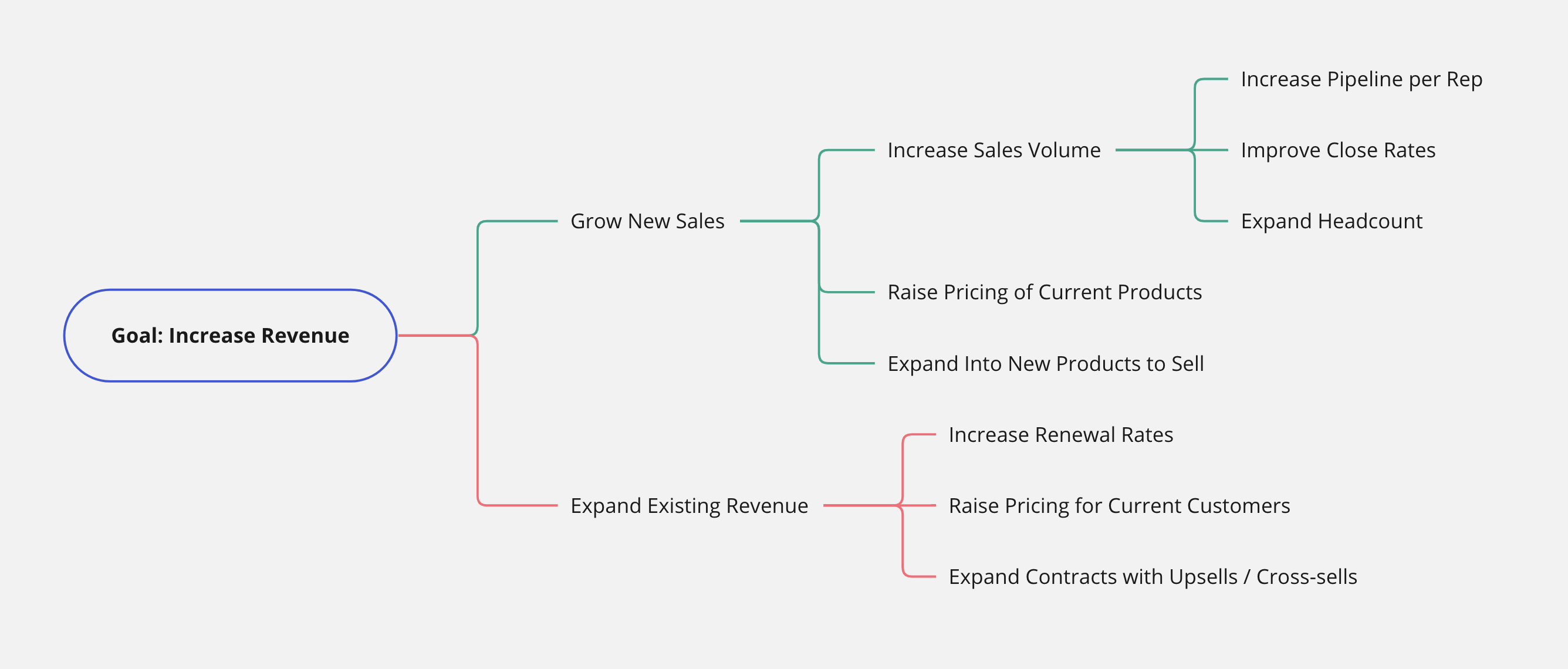
Which means your competition isn’t another vendor.
It’s the risk they prioritize an altogether different project over yours.
For example, say your product helps ramp new sales reps. By actively choosing this path to new revenue, they’re choosing not to invest more time and budget into the other routes above.
Of course, not everything is a binary, either-or choice. But the point is this:
You need to understand if the executive believes the cost of the problem you solve, and the payoff you can unlock, is greater than the cost or potential upside of all other priorities.
To discover if you’re truly aligned on priorities, frame up a choice for them:
How does our conversation compare to the other priorities your team’s already focused on, like expanding revenue from current accounts?
Are there certain projects this discussion will need to take a backseat to?
This phrasing assumes there are higher priorities, and allows the executive to correct you if it’s not the case.
Confirm Owners & Outcomes
(Minutes :25 - :30)
At this stage, you’ll want to confirm if your conversation met the executive’s desired outcome. Did you clearly map each minute to the goal they care about?
If so, the most likely outcome is an internal referral.
That referral is worth its weight in gold. It brings priority with it. “Do this, because it matters.”
The key here is to ensure you have a specific name to work with, not a general action:
- Bad: “We’ll just need to make sure you pass our security requirements.”
- Good: “Jon Clark is our VP of Info Security. I'll need him to send you our evaluation form.”
Work on a Team, Not an Island
(Minutes :00 - :30)
Throughout the meeting, you should be able to answer every question in a way that creates intrigue and respect — but don’t expect yourself to do this alone.
Lean on your own team and champions along the way. Have your own executives in the room, ready to talk about your narrative. Ask champions to share why they believe in you.
Your job is to facilitate the discussion, not be the main voice in the room.
Post-Meeting Strategies that Sustain Momentum
Right after the meeting, you’ll want to keep up your deal's momentum with these strategies.
1/ Follow Up with a Forwardable Email
An exec-level meeting typically kicks off a new set of internal communications to the buying team. Help shape those communications by writing up a forwardable email.
That’s an email sent through one person, to reach another. There's a framework for these, here.
2/ Use No-Response-Needed Updates
Keep the executive posted on the latest progress — while minimizing the work required from them — with updates that don't require a reply. You can literally say:
< Executive >, we’re continuing to make good progress on X.
We also have Y planned for next week, and will update you after.
No reply needed here — just keeping you in the loop.
Executives like to feel that they’re in the know, and in control of what’s happening.
This type of emails create this sense, and builds the trust that you’re moving the ball forward.
By the way, this is a good question for the end of your meeting. “How would you like us to keep you updated?”
3/ Build Your Champions’ Internal Reputation
Finally, remember that in this process, you’re stepping into someone else’s house. You’re a short-term guest. But your champions will live with the executive long after you’ve left.
So your main goal in all of this is to create more internal standing for them.
You’ll know you’ve done your job if, after your meeting, your champion shares they're grateful you were part of the conversation.
Just like you’d feel if you went to a wedding, and brought John Legend with you to sing to the bride and groom. Amazing.
FAQ's on:
Why stop now?
You’re on a roll. Keep reading related write-up’s:
Draft with one click, go from DIY, to done-with-you AI
Get an executive-ready business case in seconds, built with your buyer's words and our AI.
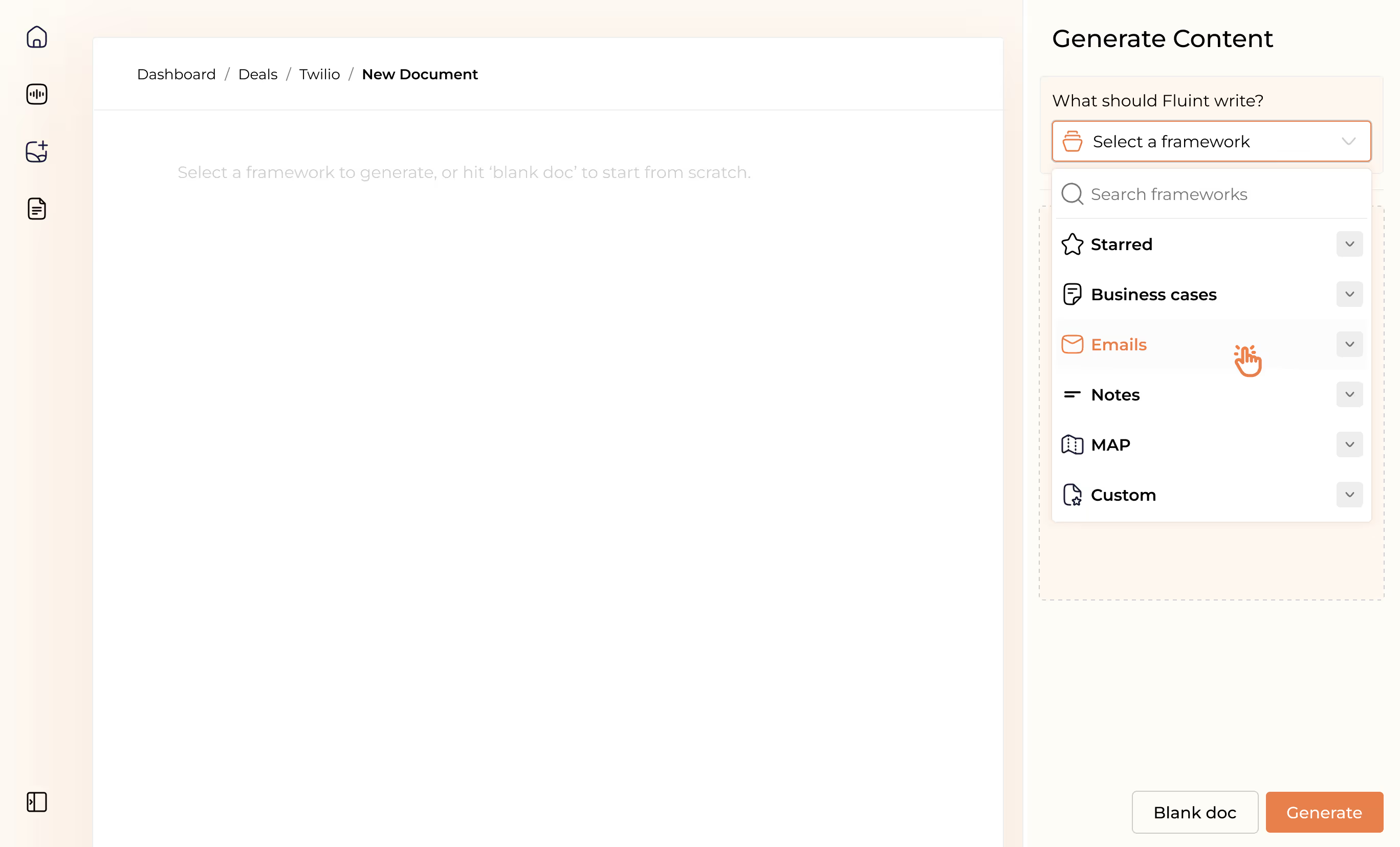
Meet the sellers simplifying complex deals
Loved by top performers from 500+ companies with over $250M in closed-won revenue, across 19,900 deals managed with Fluint

Now getting more call transcripts into the tool so I can do more of that 1-click goodness.



The buying team literally skipped entire steps in the decision process after seeing our champion lay out the value for them.


Which is what Fluint lets me do: enable my champions, by making it easy for them to sell what matters to them and impacts their role.






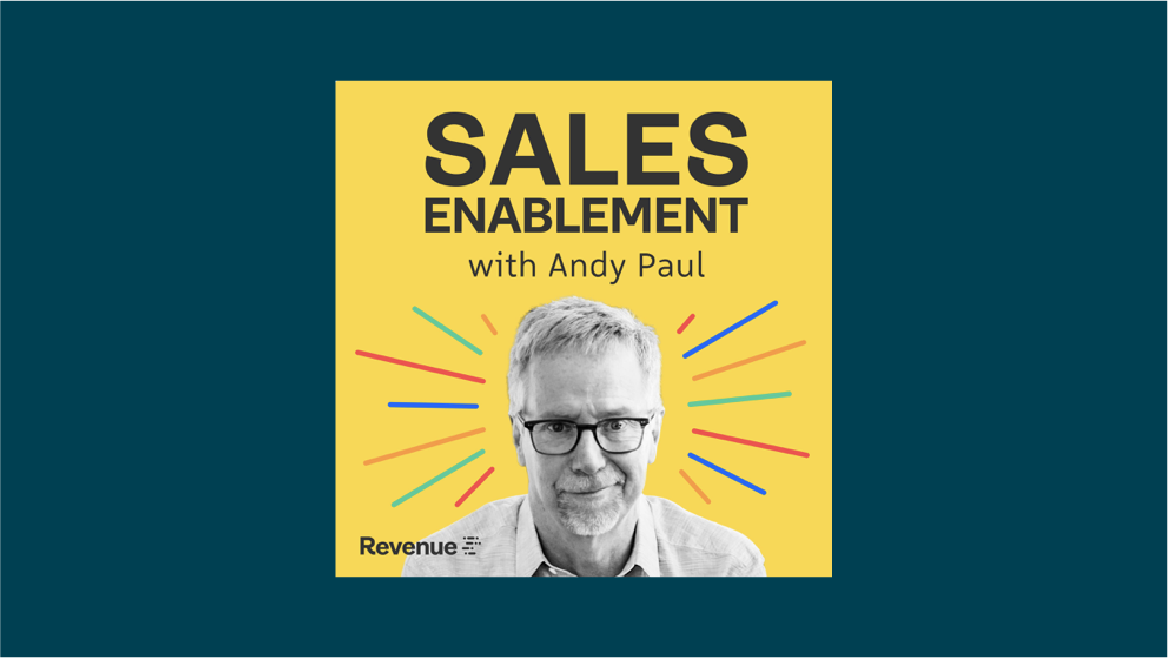

.png)